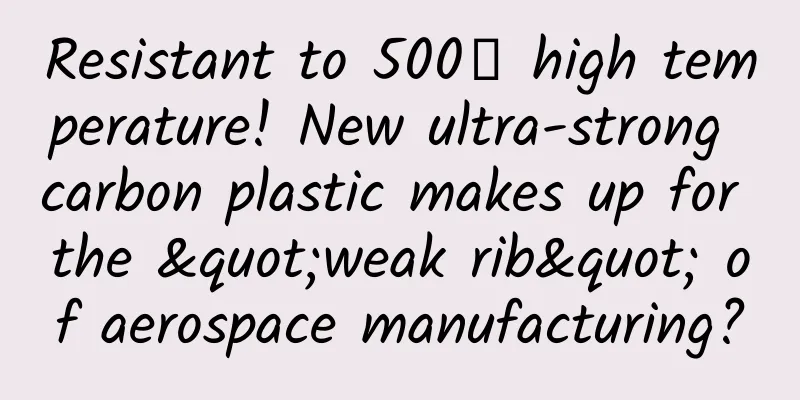Resistant to 500℃ high temperature! New ultra-strong carbon plastic makes up for the "weak rib" of aerospace manufacturing?

|
Author: Huang Xianghong Duan Yuechu In today's rapidly developing science and technology, innovations in the field of materials continue to bring new breakthroughs to various industries. Recently, scientists from Kazan Federal University and Kazan State Research University of Technology in Russia have successfully developed an ultra-strong carbon plastic based on phosphate adhesives, which has attracted widespread attention. Traditional composite materials are widely used in many fields, from aircraft manufacturing to everyday hockey sticks. However, these composite materials made of organic polymer adhesives have some "weaknesses". On the one hand, organic adhesives are flammable, which is undoubtedly a major hidden danger in some fields with extremely high safety requirements. On the other hand, its maximum operating temperature is only 300-450℃, which is difficult to meet the needs of high-precision fields such as aviation or aerospace for non-combustible materials that can withstand high temperatures above 500℃. Airplane (copyrighted image from the gallery, reprinting may cause copyright disputes) In order to overcome these difficulties, the research team took a different approach and turned their attention to inorganic adhesives. They successfully developed carbon plastics based on aluminum phosphate, aluminum boron phosphate and aluminum chromium phosphate adhesives, and used carbon fibers to enhance the performance of these adhesives. After physical and mechanical tests, these carbon fiber reinforced plastics showed extremely high tensile and bending strength and elasticity. The results of dynamic mechanical analysis showed that these materials have extraordinary heat resistance. Among them, carbon fiber reinforced plastics based on aluminum chromium phosphate performed particularly well, with the highest strength and stiffness, and products made from them can withstand temperatures above 500°C. The emergence of this new type of carbon plastic has brought new hope to many fields. In the field of aerospace, high temperature environments are the norm, and the heat resistance of materials is extremely high. The emergence of this ultra-strong carbon plastic is expected to provide a more reliable material option for the manufacture of aircraft, improving the safety and performance of aircraft. In other high-temperature working environments, such as certain special links in industrial production, this new material can also be considered to improve production efficiency and safety. In addition, this new material has the advantage of being environmentally friendly. Unlike plastics with organic binders, the newly developed composite materials do not pollute the environment during use. When these materials decompose, they will become components of clay and phosphate fertilizer, realizing the recycling of resources. To further improve the heat resistance of this new type of carbon plastic, the following aspects can be considered: 1. Material Optimization 1. Adhesive improvement: - Continue to develop new phosphate adhesive formulas, and find better heat-resistant combinations by adjusting the composition ratios of adhesives such as aluminum phosphate, aluminum boron phosphate, and aluminum chromium phosphate. For example, you can try to add some trace elements with special heat-resistant properties to enhance the stability of the adhesive at high temperatures. - Explore other types of inorganic binders, such as silicates, borates, etc., to compare and combine with existing phosphate binders to find more heat-resistant binder systems. 2. Carbon fiber optimization: - Choose higher performance carbon fiber, such as special carbon fiber with higher strength, higher modulus and better heat resistance. You can cooperate with carbon fiber manufacturers to jointly develop high performance carbon fiber specifically for this new type of carbon plastic. - Surface treatment of carbon fiber can improve its bonding strength with adhesives, so as to better play the reinforcing role of carbon fiber. For example, chemical vapor deposition, plasma treatment and other methods can be used to form a coating on the surface of carbon fiber that is more compatible with adhesives. 3. Add heat-resistant filler: - Introduce inorganic fillers with good heat resistance, such as nano-alumina, nano-silicon oxide, silicon carbide, etc. These fillers can form a heat-resistant network in the material and improve the overall heat resistance of the material. At the same time, the addition of fillers can also improve the strength and hardness of the material. - Study the effects of different filler particle size, shape and content on the heat resistance of materials, and find the best filler combination and addition amount. 2. Process Improvement 1. Preparation process optimization: - Improve the preparation process of carbon plastics, such as adopting more advanced molding methods, such as hot pressing molding, injection molding, etc., to improve the density and uniformity of the material, thereby improving heat resistance. - Control parameters such as temperature, pressure and time during the preparation process to optimize process conditions so that the adhesive and carbon fiber can be better combined to form a more stable structure. 2. Heat treatment process: - Appropriate heat treatment of the prepared carbon plastic can improve the crystallinity and order of the material, thereby improving the heat resistance. For example, annealing can be performed at a certain temperature to eliminate the internal stress in the material and improve the stability of the material. - Study the effects of different heat treatment temperatures and times on the heat resistance of materials and find the optimal heat treatment process parameters. 3. Structural design 1. Multi-layer structure design: - Design multi-layer carbon plastics, combining materials with different properties to form a structure with gradient heat resistance. For example, a coating with better heat resistance can be set on the surface of the material, the middle layer is a carbon fiber reinforced phosphate adhesive, and the bottom layer is a base material with certain strength and toughness. - Study the design principles and preparation methods of multilayer structures to ensure the bonding and synergy between the layers to improve the overall heat resistance of the material. 2. Three-dimensional structure design: - Using advanced manufacturing technologies, such as 3D printing, to design and prepare carbon plastics with complex three-dimensional structures. This structure can improve the mechanical properties and heat resistance of the material, while also enabling personalized customization and lightweight design. - Study the influence of three-dimensional structure on material properties and optimize structural design parameters to obtain the best heat resistance and mechanical properties. 4. Performance Testing and Evaluation 1. Establish a sound testing method: - Develop scientific and reasonable heat resistance test standards and methods to ensure the accuracy and reliability of test results. You can refer to international standards and industry specifications, combine the characteristics of new carbon plastics, and establish suitable test methods. - Use a variety of testing methods, such as thermogravimetric analysis, differential scanning calorimetry, dynamic thermomechanical analysis, etc. to comprehensively evaluate the heat resistance of the material. 2. Continuous optimization and improvement: - According to the performance test results, analyze the factors that affect the heat resistance of the material, and adjust the material formula, process and structural design in time. Through continuous optimization and improvement, gradually improve the heat resistance of the new carbon plastic. In short, to further improve the heat resistance of this new type of carbon plastic, it is necessary to comprehensively consider and study multiple aspects such as material optimization, process improvement, structural design and performance testing. Through continuous innovation and hard work, we believe that we can develop heat-resistant carbon plastics with better performance and provide better material choices for applications in various fields. The ultra-strong carbon plastic developed by Russian scientists, which can withstand temperatures of 500°C, is a major innovation in the field of materials. It not only surpasses traditional composite materials in performance, but is also environmentally friendly, providing new possibilities for future technological development and industrial applications. I believe that in the near future, this new material will play an important role in more fields and contribute to the progress and development of mankind. |
>>: Solving the mystery of life: Why can plants regenerate?
Recommend
Google has released the "Automatically reset permissions for unused apps" feature, which is available on all Android 6 and above devices
Automatically "reset permissions for unused ...
[Practical Application] How to use these 7 types of traffic to create a hit product?
What is a hot product? What are the factors that ...
Community operation: How to build a high-quality community from 0 to 1?
Everyone who works in the Internet industry knows...
A complete event planning framework!
As an APP operator, you often need to plan activi...
The first step in product marketing: How to identify competitors?
Recently, I often help some entrepreneurial frien...
The truth about brain-to-brain interfaces: Is the "telepathy" that Musk pursues possible?
Although we don’t have the wings of a phoenix, ou...
Common bugs in iOS development! (with solutions included)
Preface Have you ever fixed a bug and then discov...
Dog days: The sun is smaller, but the weather is hotter
As the saying goes, "train hard in the colde...
Ministry of Industry and Information Technology: my country's lithium battery production will exceed 400GWh in the first half of 2023, a year-on-year increase of more than 43%
In the first half of 2023 , China's lithium-i...
This "laxative" is actually an endangered plant in China?
There is a plant that appears very frequently in ...
Only 7 steps to easily build an AB test closed loop
As companies pay more and more attention to data,...
SAIC Motor's overall appearance at the 2017 Shanghai International Auto Show: Strong exhibition lineup demonstrates innovative strength and diversified products create value for users
(April 19, 2017, Shanghai) At the 17th Shanghai I...
Is the smart wearable industry really failing? Or is it just because your product is not good enough?
Do you think that after the decline in iPad sales...
In the era of universal live broadcast, celebrities have their own unique way of playing live broadcast
Nowadays, in the development of live broadcasting...









